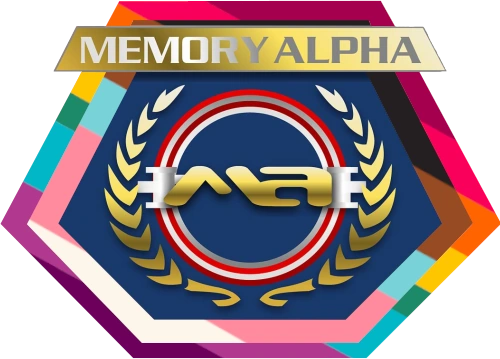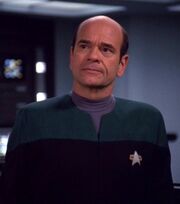
The Doctor of the USS Voyager, a noted EMH program
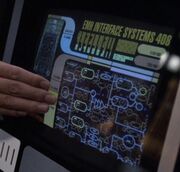
Subroutines composing an EMH holomatrix
The Emergency Medical Holographic program or Emergency Medical Holographic system, also known as the Emergency Medical Hologram (EMH), Emergency Holographic Doctor, or Emergency Medical program, was an adaptive holoprogram developed during the 2360s by Starfleet and used on a number of Federation starships during the late 24th century.
It was designed to provide short-term advanced assistance during emergencies in sickbay to the extent of literally replacing a starship's medical officer. (DS9: "Doctor Bashir, I Presume") By 2377, there had been four versions of the EMH, designated Mark I thru IV. (VOY: "Life Line")
History[]
Premise[]
One of the earliest known concepts for a "holographic doctor" was first considered, if not rhetorically, by Enterprise NX-01 Commander Trip Tucker. In 2151, Tucker argued to Ezral – a Kantare engineer who had programmed several holograms of his former crew on behalf of keeping his daughter, Liana, company – that, with regards of her welfare, "What if she gets hurt? What do you do then? Program a holographic doctor?" Ezral, nevertheless, responded simply that "we've survived here successfully" without one. (ENT: "Oasis")
Over a century later, while testing the ill-fated M-5 multitronic unit aboard the USS Enterprise, Spock lamented to Dr. Leonard McCoy that, "the most unfortunate lack in current computer programming is that there is nothing available to immediately replace the starship surgeon." McCoy retorted that, "if it could, they wouldn't have to replace me. I'd resign because everybody else aboard would be nothing but circuits and memory banks."
Later, following the demise of the M-5, McCoy observed that "compassion [was] the one thing no machine ever had. Maybe it's the one thing that keeps men ahead of them." Nevertheless, Spock still commented on the idea that, if using McCoy's memory engrams as a template for the technology used in creating the M-5, "the resulting torrential flood of illogic would be most entertaining." (TOS: "The Ultimate Computer")
By the mid-24th century, however, sufficient advancements in the field led Starfleet to commission the holo-engineer, Dr. Lewis Zimmerman, to begin work at the Jupiter Station Holoprogramming Center on the new EMH program. One of the EMH's predecessors was the hologram Haley, first activated in 2368. (VOY: "Projections", "Lifesigns")
EMH Mark I[]
Specifications[]
The Emergency Medical Holographic program (EMH) was formally known as an "EMH Program AK-1 Diagnostic and Surgical Subroutine Omega-323", though Zimmerman wanted to call his creation the "Holo-Doc", but Starfleet Command made the request to name the hologram "Emergency Medical Hologram" instead. (VOY: "Projections" ) The persona was not, however, given a formal name. (VOY: "Lifesigns")
The bit of information from "Projections" was seen on a small viewscreen okudagram detailing Zimmerman's life and work history.
The design work began around the 2360s, where it took the greatest holo-engineers in Starfleet years to develop the EMH. Among those eventually involved included Reginald Barclay. (VOY: "Message in a Bottle", "Projections", "Life Line") Following its creation, thousands of holograms based on that technology were created for various functions. (VOY: "Life Line")
The EMH was designed as "an incredibly sophisticated computer simulation," and "the embodiment of modern medicine." (VOY: "Lifesigns", "Parallax") The EMH program specifications, which were at the time considered quite "impressive", included the entire Starfleet Medical Database. In all, it contained over five million medical protocols – ranging from possible treatments to surgical procedures (including one developed by Dr. Leonard McCoy), the collective medical knowledge of over three thousand cultures (including every Federation world), it further possessed information from two thousand medical reference sources (including Gray's Anatomy and Comparative Alien Physiology), and the experience of 47 individual medical officers. (VOY: "Parallax", "Ex Post Facto", "Lifesigns", "Meld", "Message in a Bottle", "Relativity", "Virtuoso", "Critical Care") Above all, the EMH was programmed with the Hippocratic Oath, that was, an EMH was required that it "do no harm." (VOY: "Darkling", "Bliss", "Critical Care"; PIC: "Broken Pieces")
The universal translator algorithm was written into the EMH's matrix. (VOY: "Gravity")
It was designed and programmed solely as a short-term emergency supplement to the medical team otherwise found aboard a starship, until a permanent replacement could be found, and therefore, was only meant to function for a maximum of 1,500 hours (62.5 days); after this time, memory degradation would occur. (VOY: "Caretaker", "The Swarm")
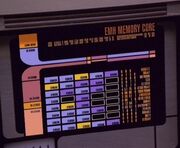
A diagram of The Doctor's memory files
The EMH was also supplemented with contingency programs and adaptive programs to learn while serving as a supplement of a normal medical staff in cases of emergency. (VOY: "Ex Post Facto") It contained fifty million gigaquads of computer memory, which was "considerably more than most highly developed humanoid brains." (VOY: "Life Line") Memory files were stored in the EMH memory core, where memories concerning a specific subject or period of time could be deleted. (VOY: "Latent Image") Additionally, while not designed to act as ship's counselor, the EMH had been programmed with sufficient psychological knowledge to note observational concerns. (VOY: "Darkling")
Beginning around 2370, the entirely new EMH system began to see installation aboard newly launched Intrepid-class and Nova-class starships. (VOY: "Equinox", "Relativity") By 2371, Starfleet was still being considered for installation throughout the rest of the fleet. (VOY: "Relativity") In all, 678 Mark Is were created. (VOY: "Life Line")
Starfleet later requested that Dr. Zimmerman design an EMH supplement, designed to operate as a full-time doctor in any posting where life support or living space was at a premium and the primary mission did not require the doctor to leave sickbay. As a result, the research and design for the Long-term Medical Holographic program (LMH) was begun in mid-2373. While Deep Space 9 did not have an EMH installed initially, as it was incompatible with the station's Cardassian technology, one was later installed that year as a way to transfer its data into the LMH. (DS9: "Doctor Bashir, I Presume")
Design flaws[]
"Inferior?"
"Beady eyes, terrible bedside manner. I recognize you."
Dr. Zimmerman, proud of his achievement, decided to program the EMH with both his physical, and most notably, psychological characteristics. (VOY: "Life Line")
Although later deemed to be a design flaw, the EMH had a rather acerbic personality, due primarily to the fact that it was "designed to practice medicine as efficiently as possible," enhancements, such as carrying on small talk or knowledge of "pithy Earth trivia" was viewed by its programmers as means of cluttering up its memory and compromising its performance. (VOY: "Persistence of Vision", "The Swarm", "Future's End, Part II", "Relativity") Some biological Starfleet doctors even went so far as to object to the use of the EMH. Doctor Beverly Crusher swore that she would never use one, although she was forced to do so in order to create a distraction while the Borg tried to assimilate the USS Enterprise-E, allowing her, her medical staff, and her patients, notably Lily Sloane, to escape from sickbay. (Star Trek: First Contact)
Eventually, it was concluded that the EMH Mark I was defective and they were retired from the Medical Corps. One key factor being that Dr. Zimmerman did not take into account that his own personality, given as that of the EMH, resulted in a poor bedside manner for a medical doctor. The resulting hologram was arrogant and irritable, and as a result was poorly received by many Starfleet doctors. This, in turn, spawned nicknames like "Emergency Medical Hotheads" and "Extremely Marginal Housecalls." According to Zimmerman he tried to save face and have them decommissioned, but "Starfleet, in its infinite wisdom, overruled me and reassigned them all to work waste transfer barges." (VOY: "Life Line") Later, the Mark Is were also deployed in other menial tasks, like dilithium mining. (VOY: "Author, Author")

Several EMH Mark Is mining dilithium
By 2378, the Mark I programs were reconfigured to work at a Federation mining colony in replacement of other forms of labor. These programs, having been reassigned to their new function, were able to obtain bootlegged copies of the holonovel Photons Be Free and view them. One of the EMH miners found the holonovel "provocative". (VOY: "Author, Author")
The fact that the reconfigured Mark Is could view holonovels suggests that they retained at least some level of sentience left over from their original medical programming.
Notable extended service[]
The most notable EMH in Zimmerman's series was the Mark I installed aboard the USS Voyager, known simply as The Doctor. The Doctor, who ran almost continuously for eight years, far exceeded the abilities of his original programming, and was forced to expand his programming extensively to keep up. This EMH originally objected to being the replacement for the entire medical staff, and after having had surpassed its expiration date, its life was fortunately extended with the help of his colleagues, and his program was altered to overcome this shortcoming. (VOY: "The Swarm")
After the EMH Mark II supplanted the "inferior" Mark I, the only remaining versions to fulfill their original programming were aboard the USS Voyager and the USS Equinox, which were both stranded in the Delta Quadrant and had to implement the emergency holograms for extended periods of time. However, a notable caveat was that the crew of the Equinox deleted their EMH's ethical subroutines in order to allow him to act contrary to the Hippocratic Oath. In 2376, the Equinox EMH was deleted while in Voyager's database, leaving Voyager's Doctor as the only known remaining Mark I still operating as an EMH. (VOY: "Equinox", "Equinox, Part II")
Voyager's EMH developed a distinct personality over the ship's seven-year-long journey to the Alpha Quadrant. Despite this, The Doctor was not granted the rights of a living person by a Federation Arbiter, although he did determine that The Doctor fulfilled the requirements of an artist under the law. The Arbiter did, however, encourage The Doctor to pursue recognition as a sentient being at a later point in time. (VOY: "Author, Author")
An ability unique to The Doctor, Voyager's EMH was able to leave sickbay or the holodeck and to roam freely with the help of a mobile emitter (originating from 29th century technology). (VOY: "Future's End, Part II") Voyager's EMH was even given the responsibility of commanding the ship as the Emergency Command Hologram (ECH) if the ship's commanding officers were not present, incapacitated, or dead. (VOY: "Tinker Tenor Doctor Spy", "Workforce", "Workforce, Part II", "Renaissance Man") By 2385, sentient Emergency Command Holograms were "something of a rare breed." (PRO: "Ouroboros, Part II") Upgrades to later ships such as the Prometheus-class, (VOY: "Message in a Bottle") Protostar-class and Lamarr-class enabled holograms to move about the ship freely, although The Doctor remained unique in his ability to move about freely in locations where there were no holoprojectors. (Star Trek: Prodigy)
The Doctor continued to remain active for years more, even after Voyager was decommissioned. In 2384, he became the chief medical officer of the new USS Voyager-A and was one of its senior officers alongside Janeway, Commander Tysess, and Councilor Noum, the latter of whom had served as the chief medical officer on Janeway's previous ship, the USS Dauntless, and showed no reservations about working under The Doctor instead on this new ship. (PRO: "Into the Breach, Part I") Along with his medical duties, The Doctor occasionally served as a bridge officer on the ship's classified maiden voyage. (PRO: "Into the Breach, Part II", "Ouroboros, Part I", "Ouroboros, Part II")
EMH Mark II[]
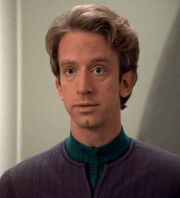
A second generation EMH
To address the flaws in the EMH Mark I, Dr. Zimmerman began work on the Mark II, a prototype of which was finished in time to be included in the sickbay of the USS Prometheus in 2374.
While the Mark I's outward appearance was a copy of its inventor, a disillusioned Dr. Zimmerman changed the outward appearance of the Mark II. Furthermore, the patterns of behavior of the following versions were designed to be more pleasant and courteous. To achieve this, Zimmerman initially tried to improve on the programming of the Mark I, but eventually decided to create the Mark II from scratch. In addition to that, new ship designs like the USS Prometheus enabled full mobility for the EMH, as the whole ship was outfitted with holographic projectors.
When The Doctor was sent in a holographic data stream to contact the USS Prometheus, he found the starship in the hands of Romulans, who had killed the Starfleet crew and captured the ship. The Doctor activated the ship's EMH, a Mark II, to help him recapture the ship, although the Mark II initially preferred to just deactivate and wait for rescue, and then treated The Doctor as inferior despite the latter's vastly superior life experiences. The Doctor ultimately persuaded the Mark II to take action and help him. They planned to disable the Romulans by venting an anesthetic gas, but The Doctor was captured by the Romulans when he attempted to reach the environmental controls on the bridge. During The Doctor's interrogation, the Mark II simulated a bio-hazard, opening the vents which released the gas, knocking out the Romulans. The Doctor and the Mark II successfully fought off Romulan warbirds using the ship's experimental weapons systems, returned the ship into Starfleet's hands, and informed Starfleet that Voyager was in the Delta Quadrant. (VOY: "Message in a Bottle")
By 2377, the Mark II had been replaced by a Mark III, followed by a Mark IV. (VOY: "Life Line")
Neither the Mark III nor Mark IV programs were shown on-screen, nor was it revealed what happened to the Mark II.
Late century design[]
By late century, EMH programs, as well as variations on the "emergency" theme, were all incorporated into the customizable Emergency Hologram basic installation, which was available for civilian use. Such packages were available onboard Kaplan F17 Speed Freighters. (PIC: "Absolute Candor", "The Impossible Box")
32nd century design[]
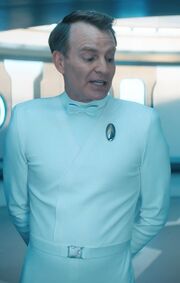
Eli, an EMH
EMH programs continued to be used by the Federation and Starfleet. One, known as Eli, served as medical officer under Admiral Charles Vance at Federation Headquarters in 3189.(DIS: "Die Trying", "There Is A Tide...")
Mechanics[]
The EMH was a holographic simulation of a Human, but with no internal organs beneath the apparent surface to conserve computer power. EMHs were not equipped with reproductive organs. The Doctor, however, wrote additional routines into his holomatrix to facilitate romantic endeavors and has also had several relationships, one of which inexplicably resulted in a son. (VOY: "Message in a Bottle", "Blink of an Eye")
The containment fields could be shut off, allowing objects and people to pass through them – an EMH's cohesion could range from solid to intangible. (VOY: "Phage")
The EMH's imaging system and tactile acuity subroutines allowed him to perform, "and in many cases improve upon, the most delicate tactile maneuvers required by a dizzying array of surgical procedures." (VOY: "Lifesigns")
When he was first activated, the Mark I EMH did not have the ability to deactivate himself after he finished his duties. (VOY: "Eye of the Needle") Auto-initiation of the EMH program could be achieved when a ship-wide red alert was initiated. (VOY: "Projections")
Written as a supplement to USS Voyager's EMH, The Doctor was given the ability to self deactivate by issuing computer command "Override Command 1-EMH-Alpha; End Program". (VOY: "Jetrel") Though seemingly unrelated, this was a standard feature for the EMH Mark II. (VOY: "Message in a Bottle")
| Emergency holographic programs |
|---|
| Command • Engineering • Hospitality • Medical • Navigational • Tactical • Training |
Appendices[]
See also[]
- "I'm a doctor, not a..." quotes:
- Standard form quotes from Voyager's EMH, The Doctor
- Variants from The Doctor
- Standard form quotes from other Starfleet EMHs
- Standard form quotes from Voyager's EMH, The Doctor
- Jupiter Station Diagnostic Program Alpha-11
- Long-term Medical Holographic program
Appearances[]
- DS9: "Doctor Bashir, I Presume"
- VOY:
- Every episode except:
- Star Trek: First Contact
- PIC:
- DIS:
Apocrypha[]
Despite Doctor Crusher's distaste for the EMH, she was forced to activate the EMH of the Enterprise-E during the events of The Q Continuum trilogy, when the Enterprise was attacked by the Calamarain during a mission to the Galactic barrier.
In the Star Trek: Prometheus trilogy, it is revealed that, even after the upgrade to the Mark III and Mark IV EMH, the Prometheus has retained the Mark II, even giving him the nickname 'Tre' for his habit of carrying around a tricorder when he can make such diagnostics on his own.
In Star Trek Online's Federation tutorial, players encounter a new version of the Emergency Medical Hologram (EMH Mark VI) serving aboard the USS Khitomer. Resembling a Vulcan with silver hair, this EMH, in dialogue released on YouTube but not included in game, claims to have a "personality matrix [that] combines qualities of more than twenty physicians, scientists, and counselors – including Admiral Beverly Crusher of Starfleet Medical, Ambassador Spock, and Ghee P'Trell of Andoria." He is voiced by Zachary Quinto. [1] Also in Star Trek Online, Emergency Medical Holograms, alongside the new Emergency Engineering Holograms and Emergency Security Holograms, can be acquired as Duty Officers. [2]
External link[]
- Emergency Medical Hologram at Memory Beta, the wiki for licensed Star Trek works

